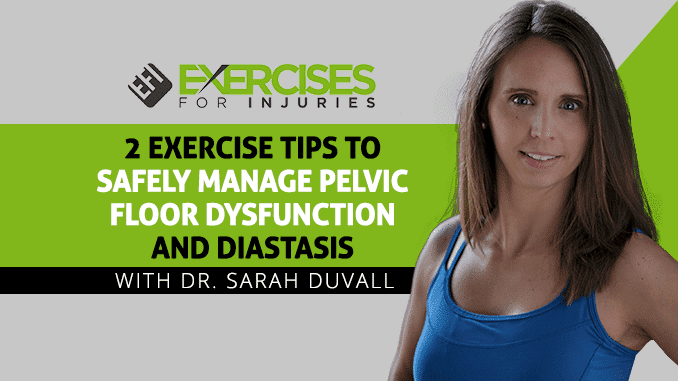
For women, pelvic floor dysfunction and diastasis recti can cause discomfort that can increase during physical activity. This can lead to problems such as incontinence, poor performance in your sports activities, and even weight gain. Here are some ways to manage pelvic floor dysfunction and Diastasis safely and effectively; keep reading to learn more.
CLICK HERE to watch the YouTube video interview.
3 Factors that Affect Pelvic Floor Disorder
Pelvic Floor Dysfunction and Diastasis is a condition that affects the connection between the pelvic bones. Certain factors, such as pregnancy, childbirth, or injury, can contribute to this condition.
There are three different stages:
- Diagnosis stage (two weeks)
- Treatment stage (six weeks)
- The recovery process after six months post-treatment with restorative exercise for one year
These stages vary according to individual needs and personal health goals.
How is Pelvic Floor Dysfunction Treated?
When you want to treat pelvic floor dysfunction, start with the head and move down through your body. Examine all areas by looking at how the pelvic floor is affected. Then look at what is not meeting expectations, like if has forward head posture, which often leads to an under-active or over-tightened pelvis and contributes greatly to various issues in our lives, including bladder control problems, menstruation, etc. Seeing that this person also doesn’t breathe correctly can be more than just another piece of information contributing to their diagnosis and a treatment plan for pelvic floor disorder (PFD). Based on this knowledge about your breathing patterns will lead to other related areas, such as muscle function in the diaphragm (if there are any abnormalities), so these individuals have a healthy sense of deep breathing when inhaling, allowing them better health outcomes overall.
Inhaling and Exhaling
Inhaling and exhaling together is a natural system. The more you breathe, the more oxygen is delivered to tissues in your body. So, what happens when someone holds their breath? They develop shallow breathing patterns that put pressure on their diaphragm instead of relaxing it as they should.
All these things contribute to poor posture and spinal mobility problems like herniated disc development from excessive weight-bearing stresses and chronic back issues/pain because there are no real weak points where people can allow for proper alignment through stretching routines or working towards a healthier lifestyle overall.
3 Ways to Heal Diastasis Recti
What is the first thing to do if you have a diastasis? Instead, muscle groups support you as you pull up on yourself, which is much safer for postpartum women at risk for Diastasis Recti later in life.
One common thing that often happens, especially when breastfeeding, is observing their chest down to their belly button. During this process, the ribs would flare outwards because those babies were very intense in feeding. Because of all these factors happening at one time, there was not enough room for them to go back into their obliques and interossei muscles underneath it all, which would help pull everything back together again.
So when your rib cage is closed again after diastasis recti have occurred, what does happen? This allows your diaphragm to function properly, so you don’t struggle with breathing anymore! Instead, muscle groups support you as you pull up on yourself, which is much safer for postpartum women at risk for Diastasis Recti later in life.
So don’t draw on your belly button, and you will not be able to draw air into or out of it. The diaphragm is the muscle in your chest that works with all the other core muscles to help move air in and out of the body during breathing, as well as help keep our heart moving blood around our body.
Two Exercise Tips to Manage Pelvic Floor Dysfunction and Diastasis Safely
It depends on what stage of life you’re in. But if you’re a postpartum woman, I truly believe you should get your body back from two weeks and get all of these things functioning correctly. And know that whole bounce back or get your body back thing is so Tabby right now with just let’s support women where they’re at. So help get your body functioning as it should before you dive back into regular exercise. But if that is not the case, then basically curtail the things hurting your progress. So, forward front-loading for the Diastasis or lots of jumping for the pelvic floor are things that are damaging and aren’t helping your progress.
Here’s a list of interviews that might interest you:
- The #1 Flat Butt Fix
- The #1 Worst Exercise That Ages You Faster
- 5 Mistakes People Make When Dealing With Foot Pain
If you are looking for more exercises that help strengthen your core, tighten your abs, slim your waist and flatten your stomach while keeping yourself injury-free, click here to check out the Invincible Core program.


